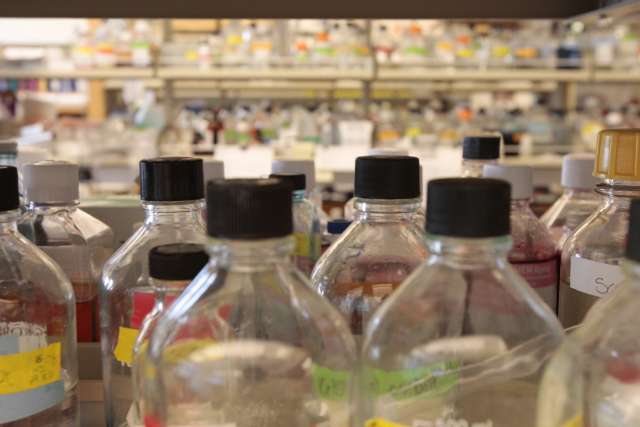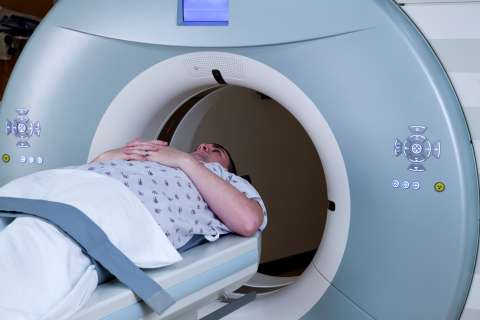Post-operative infections are among the most dreaded complications of all surgeries. In orthopedic surgery, treating one of these infections requires removing and replacing the implant — a series of procedures that are costly, complex and sometimes unsuccessful.
When bacteria adhere to the surface of orthopedic implants, they form a self-protective layer of proteins called a biofilm, rendering them immune from antibiotics. A patient instead must return to the operating room for multiple surgeries to remove and replace the implant. For those who are older, lower income or immunocompromised, the risk of infection can be higher. Finding a clinician who will perform the revision surgeries may be difficult.
Infection risk is constantly on the mind of Nicholas M. Bernthal, MD, who specializes in pediatric orthopedic oncology.
“We put a kid through a year of chemotherapy, and we do these massive surgeries where we take out huge chunks of their bones, spine or pelvis, replacing them with implants. The surgery is successful, the cancer is cured, and then, they get an infection that is truly life altering,” says Dr. Bernthal, chair and executive medical director of orthopedic surgery at UCLA’s David Geffen School of Medicine. “It is the ultimate perverse irony that these kids can defeat these deadly cancers but spend much of their lives fighting persistent infections.”
Now, a point-of-care solution designed at UCLA could make implant-associated infections a problem of the past.
A preventative strategy
Affecting 1 in 100 patients who undergo hip or knee replacement surgery alone, implant-associated infections are costing the U.S. health care system billions of dollars, according to Dr. Bernthal, who is also affiliated with UCLA Mattel Children’s Hospital and the Jonsson Comprehensive Cancer Center.
“These numbers are dramatically higher in health systems around the world that do not have resources dedicated to sterility, patient optimization and modern implants,” he says.
Desperate to find a solution, Dr. Bernthal teamed up with Tatiana Segura, PhD (now a professor of biomedical engineering at Duke University), and a team of engineers at UCLA to develop a preventative strategy.
The researchers considered three criteria in their design: First, the solution could not change the implant manufacturing process. If the researchers were to develop a new antimicrobial implant, for instance, these medical devices would need to be sold as biologics, subjecting them to new regulatory scrutiny and an expiration date.
Secondly, the solution would need to be customizable. “It dawned on us that patients from different environments get different implant-associated infections, so if you put an antifungal on an implant in an environment that is a risk for being infected with bacteria, you’ve done nothing for them,” Dr. Bernthal says.
Lastly, the researchers wanted to develop a method that would be practical for a surgeon to prepare quickly and use directly in the operating room.
Their solution? Dr. Bernthal and Dr. Segura designed a surface modification platform that could be applied to implants during surgery that would kill or slow the spread of microorganisms.
Using a method called “click” chemistry (simple reactions that can happen quickly at room temperature), surgeons can combine the surface modification, which is made of two polymers, with the antibiotic or antimicrobial of their choosing. Once the final product is mixed, it can be applied directly to the implant by dipping, painting or spraying.
Published in Nature Communications, a study led by Dr. Bernthal and Dr. Sergura showed that applying the antimicrobial coating to implants successfully prevented infection in 100 percent of mouse models. The researchers are now working with the U.S. Food and Drug Administration to set up clinical trials and test the technology in human patients.
Dr. Bernthal is optimistic about the surface modification’s ability to prevent infection, but he is convinced that a multipronged approach is still needed. For example, his lab helped to develop an antibody that is currently in Phase I/II clinical trials to treat resistant implant infections, and he is leading a consortium aimed at improving patients’ immune responses to pathogens prior to surgery.
“This problem is so massive, that there is probably not going to be a singular solution that gets us to zero infections,” Dr. Bernthal says. “But if we can get our patients as optimized as possible through immunomodulation, if we can get our implants re-engineered to be antimicrobial weapons – rather than sitting ducks for bacterial contamination – and if we can develop antibody-based treatments for the percentage of infections that get past those two barriers, then we finally can get the risk percentage very close to zero.”




